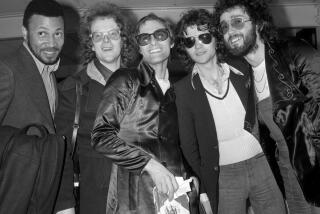Harvey Ball; Created âSmiley Faceâ Design
Harvey Ball, a commercial artist whose design of a âsmiley faceâ became a pop icon for the 1970s, died Thursday in Worcester, Mass., after a short illness. He was 79.
Although there have been many pretenders, Ball was the originator of the ubiquitous feel-good symbol: a yellow circle outlined in black, with two dots for eyes and a loopy grin.
Over the decades, the image that began as a lapel button has been emblazoned on everything from beach towels to boxer shorts. Collectors bombard the Internet auction site eBay with hundreds of vintage smiley-face wares.
Ball never reaped profits from âSmiley,â as he called the design, which fell into the public domain when he failed to copyright it. His total fees for designing the emblem: $45.
But he always shrugged off questions about whether he resented those who have grown rich off his creation.
âHe never thought he was put here to chase money,â said his son, Charlie, a Worcester attorney. âBut he understood the power of [the smiley face] and was enormously proud of it. He left this world with no apologies and no regrets, happy to have this as his legacy.â
The smiley face was born in discord. In the early 1960s a Worcester company, State Mutual Life Assurance, bought the Ohio firm Guarantee Mutual. The takeover created a work force so unsmiley that a State Mutual vice president proposed a âfriendship campaignâ to bolster employee morale.
Needing a graphic symbol for the campaign, the companyâs marketing director turned to Ball, who had done some work for her through the ad agency he established in 1959. Could he concoct something around a smile?
Ball started sketching. Fearing that a grumpy employee would turn the smile upside down into a frown, he added the eyes. He settled on yellow for the background because it was a âsunshineâ color. The work took about 10 minutes.
State Mutual put the smiley face on buttons, distributing about 100 of them in 1964. It became the centerpiece of a companywide campaign urging employees to smile when they answered the phone, paid a claim and typed a report.
The buttons became so popular that State Mutual began reordering them in batches of 10,000 to fill requests from customers and agents. Before long, the smiley face leaped into popular culture.
By 1971, more than 50 million smiley face buttons had been sold, and the image was popping up on coffee mugs, stickers, T-shirts and countless other items.
âI was looking around, and I said, âFor Godâs sake, the smileyâs everywhere,â â Ball recalled in the Boston Globe a few years ago.
Born in Worcester, he attended the Worcester Art Museum school before serving in the Army during World War II. During a Japanese mortar attack on Okinawa, a shell landed a few feet from him, killing three buddies. But Ball walked away unscathed. As a result, son Charlie said, he returned home with the attitude that âevery day was a gift.â
So he never begrudged those who made money on his wildly popular design. What steamed him was those who tried to claim it for their own legacy. They included a Seattle advertising executive, who later recanted his story, and a pair of Philadelphia businessmen who combined Smiley with âHave a nice day.â
âI thought that was an insipid idea,â Ball said of the latter scheme.
It also riled him when a Frenchman registered the smiley trademark in 75 countries and threatened to sue U.S. firms that sold smiley face products abroad. Sue over smiles? That, Ball said, was âabhorrent.â
To set the record straight, a few years ago Ball produced a smiley face with his name in small cursive letters on the bottom. This time, he copyrighted it.
He also created World Smile Day, launched with a 1999 celebration in Worcester. Having learned his lesson, he got a trademark for that too. Its purpose was simply to encourage others to âdo an act of kindness; help one person smile.â
That same year, the U.S. Postal Service issued a commemorative stamp bearing Ballâs smiley face. Chosen by the public to represent the 1970s, it earned more votes--469,867--than any other subject, outpolling disco, Earth Day, âSesame Streetâ and the U.S. bicentennial.
The emblem, Ball said, âhas gone around the world. Itâs reached everybody. Its message is as good as you can get.â Proud to be its creator, he often said, âI made the world smile.â
More to Read
The biggest entertainment stories
Get our big stories about Hollywood, film, television, music, arts, culture and more right in your inbox as soon as they publish.
You may occasionally receive promotional content from the Los Angeles Times.











